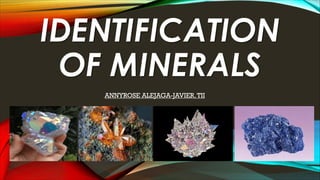
Identification of minerals.pdf
- 2. WHAT IS MINERALS? •Minerals are naturally occurring, inorganic solids with definite Chemical composition and a Crystal Lattice structure. •Minerals can be identified by their physical characteristics which are related to their chemical composition and bonding.
- 3. WHAT IS MINERALS? ØCrystal Lattice – is the geometry of how the atoms are arranged and bonded together. ØChemical formula – are the types and proportions of the chemical elements.
- 4. HOW ARE MINERALS IDENTIFIED? •Mineralogist are scientists who study minerals and although they might using high-powered microscopes to identify minerals, but most are recognizable using physical properties such as; Color, Streak, Luster, Specific Gravity, Hardness, Cleavage, Fracture, Tenacity, and Crystal Shape.
- 5. COLOR • Some minerals come in many different colours. Quartz for example may be clear, white, grey, brown, yellow, pink, red, or orange.
- 6. COLOR • Color can help but do not rely on color as the determining property. For example, a quartz having a tiny amount of iron can appear purple.
- 7. STREAK • Refers to the color of a mineral’s powder and it is a more reliable property than Color because streak does not vary. • Minerals of the same color may have a different colored streak.
- 8. SPECIFIC GRAVITY • Refers to the density of the substance / mineral. • It is also refers to the mass of the mineral compared to the mass of an equal volume. • Even though the two different minerals may have the same volume, their density will vary.
- 9. HARDNESS •It is the strength with which a mineral resist its surface being scraped and punctured. •It doesn’t refer to the mineral being difficult or easy to break. •Mineral hardness can’t be specified without a specialized tools, it can only be specified with the use of Mohs Scale.
- 10. MOHS HARDNESS SCALE HARDNESS INDEX MINERALS COMMON OBJECTS SOFTER 1. Talc 2. Gypsum 2.5 – fingernail 3. Calcite 3.5 – pure, untarnished copper HARDER 4. Fluorite 5. Feldspar 5 to 5.5 – stainless steel 5.5 to 6 – glass 6. Apatite 6 to 6.5 – hard steel file HARDEST 7. Quartz 8. Topaz 9. Corundum 10. Diamond
- 11. CLEAVAGE • Breaking a mineral also break its chemical bonds and since bonds are weaker than the other bonds, each type of mineral is likely to break between weaker atomic bonds. • Cleavage is the tendency of a mineral to break along certain planes to make a smooth surfaces.
- 12. FRACTURE • It is a break in a mineral that is not along a cleavage plane and unlike a cleavage, a fracture is not always the same between minerals. • A fracture may be Conchoidal, which is similar when a thick piece of glass breaks, or Irregular, which does not show any of the qualities of other fracture types.
- 13. TENACITY • Refers to the behaviour of the mineral under deformation or stress such as; cutting, crushing, bending or hitting. • Simply defined as the reaction of the mineral towards forced change.
- 14. CRYSTAL SHAPE • All minerals are crystalline but only some have the opportunity to exhibit the shapes of their crystal forms. • If a mineral has a space while it grows it may forms natural crystal, with a crystal shape following the geometry of the Mineral’s Crystal Lattice.
- 15. CHEMICAL PROPERTIES OF MINERALS •Aside from their physical characteristics, minerals can also be identified through their chemical properties. •All minerals have a certain chemical structure. •The Solubility and the Melting Point of the minerals can be utilized to described a mineral.
- 16. SOLUBILITY •The ability of a substance to dissolve in a solvent at a specified temperature. •The solubility of a mineral can expose the said mineral’s chemical structure and components that comprises the mineral.
- 17. MELTING POINT •The specific temperature wherein a solid substance is converted to a liquid. •Minerals with highly compact atomic bonds have a high melting point. •This is also instrumental towards the study of minerals as it provides additional data in regards to the mineral’s properties and characteristics.
- 18. LUSTER •Is the the relative differences in the opacity and transparency of a mineral as light is reflected on its surface. This describes the ‘sparkles’ of the mineral surffaces.